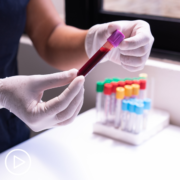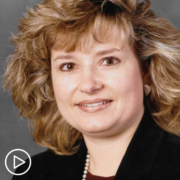Expert Overview | AML Treatment Options and Phases of Therapy
Expert Overview | AML Treatment Options and Phases of Therapy from Patient Empowerment Network on Vimeo.
What are the treatment options and phases of therapy for AML? Dr. Gail Roboz discusses the various therapies available to treat AML and to maintain remission, the timing of these therapies, and novel treatment approaches offered.
Related Resources:

|

|

|
Transcript:
Katherine Banwell:
Dr. Roboz, would you provide a brief explanation of the phases of therapy for AML?
Dr. Gail Roboz:
Yeah. So, here, too, I have to say that it’s more confusing than it used to be for the following reasons. So, historically and currently, we typically talk about induction as the first therapy that you’re going to get to get into remission.
Then, the treatment paradigm is you do something to get into remission; do some treatment to get into remission. After that, in the realm of post-remission therapy, there are different things that can happen. There can be something called consolidation, which might be another round of chemotherapy. Some patients get consolidation, some patients don’t. After consolidation, there can be a transplant.
So, you get into remission, you may or may not get a little bit of what’s called consolidation chemotherapy, and then go on to a transplant.
However, sometimes either after the transplant or after chemotherapy before ever getting or instead of ever getting a transplant, there might be ongoing treatment in a lower intensity ongoing basis that is called maintenance.
So, you’ve got to think about it as induction as what happens first, consolidation is something that happens when you’re in remission, and then maintenance usually refers to ongoing therapy that is different from consolidation.
It’s usually lower intensity, easier to take, oral types of treatment that may go on and on. And just to be incredibly confusing, it’s different from something like breast cancer, where often the patients are given, “You get six cycles of this, and then you’re done.” From AML, there’s actually often not that type of an obvious plan right out of the gate for the patient.
The answer will be, “It depends.” It depends. It depends how your treatment looks at this point in time. It depends how you look at this point in time.
So then, the patients say, “Well, aren’t you going to cure me of this? What are you doing? Aren’t you going to get rid of it?” So, historically, there are some patients who get cured with chemotherapy. They get chemotherapy to get into remission, they get some chemotherapy afterwards, and there’s a cure rate for some patients with that. The majority of patients who are cured with AML get an allotransplant, or a transplant from somebody else.
Then there’s a whole group of patients where we’re asking the question now, is it possible to get those patients beyond five years – so in oncology, five years is typically defined as cure. Can we get some patients with ongoing therapy to that past-five-year mark without a transplant? That’s in the zone of the ‘coming soon.’ Don’t have a ton of patients in that group right now, but hopefully we will.
Katherine Banwell:
You’ve mentioned some various treatment types that are used to treat AML. Can you share a brief overview of available treatments?
Dr. Gail Roboz:
So, the terminology that we use is a little bit annoying, because it is a little bit general. We say intensive and not intensive.
But historically, intensive chemotherapy referred to a combination of generally two types of agents, cytarabine (Cytosar-U) and an anthracycline, which is a class of chemotherapy, that either just those two together or in combination with sometimes a third or a fourth drug usually keeps people in the hospital for around a month. Not that the chemotherapy takes that long, but the treatment gets rid of basically a lot of cells in the bone marrow, good guys and bad guys, and it takes about three weeks for those normal cells to recover.
So, a standard intensive induction for AML is often around three to four weeks in the hospital, somewhere between three and five or so days of chemotherapy up front, depending on exactly what the protocol is. The classic regimen is actually still called 3+7, three days of one drug, seven of the other. But there are many variations of that that work.
The chemo is then stopped, the patient hangs out in the hospital, very frequently getting transfusions and antibiotics, and we wait for the bone marrow to recover.
Another current path that many patients are getting – almost all older patients, with ‘older’ being defined not by a specific age cutoff, but often 75 and older, almost everybody agrees no longer gets the classic chemotherapy that I just described. At some institutions, that 75 is going down, and even 70 and 65 and above are getting a new type of therapy, mostly because the new type of therapy is working pretty well. That is a combination of something called a hypomethylating agent.
Drugs like azacitidine (Vidaza, Onureg) or decitabine (Dacogen) in combination with a pill that has changed the landscape of AML more than any other called venetoclax (Venclexta). Venetoclax is a drug that is not exclusively used for AML.
It actually was originally approved for another type of leukemia. But I think that not many people would argue with the statement that what has changed absolutely the face of AML treatment has been this drug, because it’s a BCL2 inhibitor. What it does is it actually – cancer cells and leukemia cells in particular are very, very good at staying alive.
They don’t undergo cell death, they don’t want to die, and venetoclax brings down their forcefield so that those cells can actually undergo apoptosis and die.
Venetoclax in combination with azacitidine or decitabine has transformed the care of the disease, because many patients older than 65 – and the median age of diagnosis of AML is around 68 to 70. So, many patients never were well enough to have the intensive therapy. They weren’t going into remission, and they weren’t having prolonged survival often beyond a few months.
But now, those patients do actually much better with the combination of aza [azacitidine] and venetoclax. So typically, the induction path is going to be deciding who gets an intensive therapy backbone, usually associated with long hospitalization. Who gets a less intensive backbone – by the way, that is often associated with just the same hospitalization. So, that’s why I don’t love the term ‘low intensity,’ because that implies that it doesn’t work.
It does, and it also implies that you’re not going to be in the hospital. You probably will, because in the same way as for the more so-called intensive therapies, getting into remission involves getting rid of bone marrow cells and waiting for the normal ones to recover. Even if you are a patient who is getting the venetoclax combined with the azacitidine or decitabine, which is typically called low intensity, you may very well be in the hospital for a month.
Because depending on where you live and who your family is and how sick you might be, you will probably want us to watch you carefully during that first month, but it’s worth it. Because if you have a good chance of getting into remission, remission is what makes life better and life longer. So, we want to get patients into remission, even if it means upfront time in the hospital.










